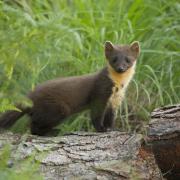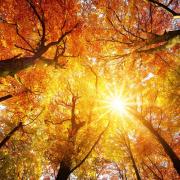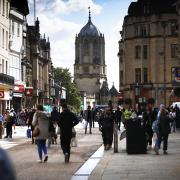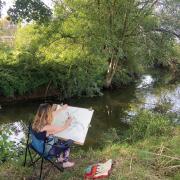For many people, trees and woodlands are emblematic of our deepest connections with Nature. They are a constant in our culture and histories, from the Hundred Acre Wood to the adventures of Robin Hood, and with good reason. Our native woodlands are vibrant, wild, and shrouded in mystery — the perfect place for Nature to thrive.
Ancient native woodlands in particular hold a wealth of life, with a complex weave of ecological networks and relationships between a huge array of diverse species. For example, the mighty oak, a staple of British woods, provides habitat for more than 2,300 species, from woodland birds to fungi. These long-standing woodlands also possess trees of varying ages, with old trees offering nest holes for birds like redstarts and pied flycatchers, dead and dying trees providing essential habitat for fungi and insects like stag beetles, and young trees and dense, thorny scrub creating nesting sites for warblers and nightingales. Stag beetles and nightingales, amongst other benefiting wildlife, are some of the most threatened species in the UK, so having wilder, natural woodlands which contain these habitats are critical for their continued survival.
Yet as we are now seeing the impacts of a changing climate, our woodlands are receiving increased interest in another of their magical properties — the ability to take carbon dioxide from the atmosphere, and lock it away for centuries in their branches, their roots, and within the soil. As a result, trees have increasingly been put forward as a win-win solution for Nature and the climate, but are trees always a silver bullet?

Heroic habitats
While important, trees are not the only answer to solving the climate crisis. Habitats such as chalk downland, hay meadows, peatlands, and heathland all have extraordinary value for wildlife and will play a large role in addressing the climate crisis too. Yet, in the drive to plant more trees, it is precisely these habitats that can be put at risk.
In fact, planting trees on the above habitats often does more harm than good. Trees planted on habitats such as our flower-filled meadows, most of which have already vanished in the past century due to increased agricultural intensification, can lead to a loss of wildlife, and further threaten the precious remnants that remain. Yet this bias for trees exists, as evidenced in a recent decision to replant an area of degraded heathland with conifers rather than restore it to its natural state.
Shallow peat soil is particularly at risk from tree planting, and creating new woodlands in these areas can release more CO2 than the trees end up taking in through soil degradation. Multiple examples of this were seen in the mid-20th century, when vast areas of peatland were drained, ploughed, and assailed with single-species plantations of non-native conifers in a short-sighted bid to increase timber resources.
This approach to planting trees has been rightly castigated by the majority of environmentalists and foresters alike, yet we are still seeing examples of this happening today in the increased drive to plant trees to address the climate crisis. In just one example from last year, 100 acres of bog, heath and grassland were destroyed to plant trees. So, what’s the answer? Have we learnt from the mistakes of the past?
We know that trees are not just carbon-capturing machines. They are part of a living, breathing ecosystem. When creating new woodlands, it has to be the right tree, in the right place, working with the environment around it. By ensuring that the right tree is planted in the right place, large areas of new, highly biodiverse, native woodland can be created as part of a joined-up system which benefits other habitats for Nature, whilst drawing down carbon at the same time.

Wilder woodlands
Of course, one way to get around the issue of where to plant trees is to let trees plant themselves. After all, planting trees does not create a woodland. Forests are diverse and dynamic environments which have developed over years, decades, and millennia. Their complex ecological networks are both above ground and within the soils, involving a huge array of interdependent relationships between many species. And these systems were operating long before the development of wooden stakes and plastic tree guards.
Natural regeneration is the best way of creating new, natural, and wilder woodlands for wildlife. This is particularly powerful when expanding ancient semi-natural woodland, as it allows the expansion of the entire woodland ecosystem, where new saplings can take advantage of symbiotic relationships with networks of fungi in the soil. With time and patience, this can result in stunning woodlands for wildlife, such as Siccaridge Wood in Gloucestershire.
Not only is it more cost effective than planting, but natural regeneration is also the best way of creating woodlands that are resilient to a changing climate. It allows these habitats to develop a dynamic age structure, genetic variation, and associated ecologies, where trees that grow to maturity will be best suited to their local micro-climatic conditions, such as soil type, water availability, and sunlight. All of this makes them more resilient to external pest and disease threats.

A nuanced approach
Now, natural regeneration won’t be possible everywhere, and in some locations it will need a great deal of support to get going. It is clear that expanding the UK’s network of native tree and woodland cover will have a huge role to play in rebuilding ecological networks, delivering Nature’s recovery, and tackling the climate crisis, and if we are to increase woodland cover in this country significantly then we will need to look at planting more trees.
A nuanced approach is required, one which creates more, bigger, better, and more joined-up woodlands, hedgerows, trees and scrub thriving with wildlife and accessible to people, while also ensuring protection of other vital habitats where tree planting may be more damaging than helpful. This is an approach Gloucestershire Wildlife Trust are embracing across our reserves and in two key projects: Severn Treescapes and Severn Solutions for Nature’s Recovery. Both projects look at the ways trees and wooded habitats more generally can be integrated into the existing landscape, including on productive agricultural land. A one-size fits all approach just doesn’t apply here and nuance is exactly what the challenge of increasing our tree cover needs. After all, it’s all about right tree, right place.
You can find out more about these projects and the work of GWT by heading to gloucestershirewildlifetrust.co.uk
Cotswold great – English oak
The English oak (Quercus robur) is an iconic tree with recognisable lobed leaves and familiar acorns. In winter, you can identify oaks from their trunk that leads up to thick branches and a broad spreading crown. The tips of these crowns are littered with twigs which are smooth and brown, with rounded brown buds which will become next year’s leaves. As oak trees grow, the trunks become fissured, creating a rough and cracked bark texture.
English oak trees can grow very old, living well over 500 years, and support more life than any other native tree species in the UK. Fissures and holes in the trunk can create homes for insects and birds, and purple hairstreak caterpillars feed on the flower and leaf buds. The leaf litter of oak trees also supports insects like stag beetles, and all kinds of fungi.

6 trees to spot
Holly – Look out for glossy leaves with sharp spikes, which stay on holly trees all year round, and small bright red berries bringing colour into winter.
Common beech – You can identify a beech tree in winter by its leaf buds which are pointed and long. Some beech trees might even hold onto their leaves through the winter, which are shiny, soft, and oval shaped.
Yew – Yew trees can live for hundreds of years and grow up to 20m tall. They keep their leaves through winter so look for dense, glossy, dark green needles, on densely packed branches that form mazes below the canopy.
Silver birch – Birch trees lose their triangular and jagged leaves in the winter, but you can identify a silver birch from drooping branches and the distinctive white, papery bark.
Alder – Common alder can be found along riversides and wet woodland. They lose their rounded leathery leaves in winter and woody cones hang onto the trees, which open to release their seeds.

Gardening for wildlife this festive season
Over the festive season, many of us enjoy eating food and exchanging gifts, but don’t forget to give a gift to Nature, too, by helping wildlife in your garden. Nature gives us the gift of wildlife and green spaces through the year, and you can give back in all kinds of ways.
One way to help is do nothing! Leave the leaves that have fallen to help hibernating hedgehogs and toads, and leave any pinecones and berries as they are, to help birds looking for their festive dinner.
You could fill up your bird feeders to help birds during this tough time for finding food, and put out a shallow dish of water to help birds and mammals that visit your garden. Just make sure to break any ice if it freezes on cold nights.
To go one step further, and help wildlife in the new year, you could gift your garden a native tree or shrub, which could provide food, as well as space to breed, shelter and hibernate for years to come.



























